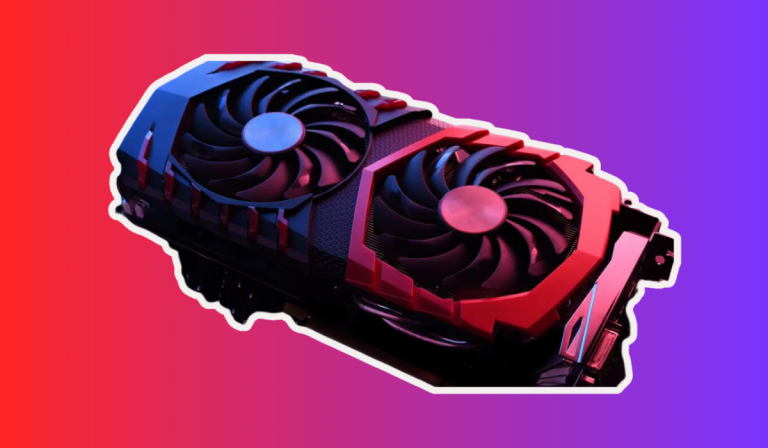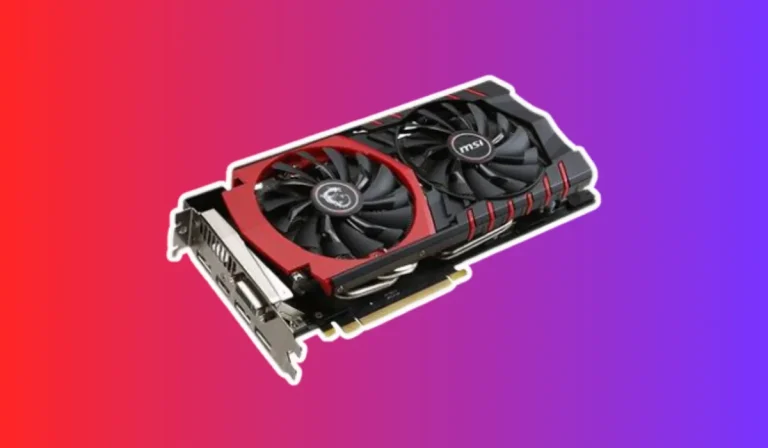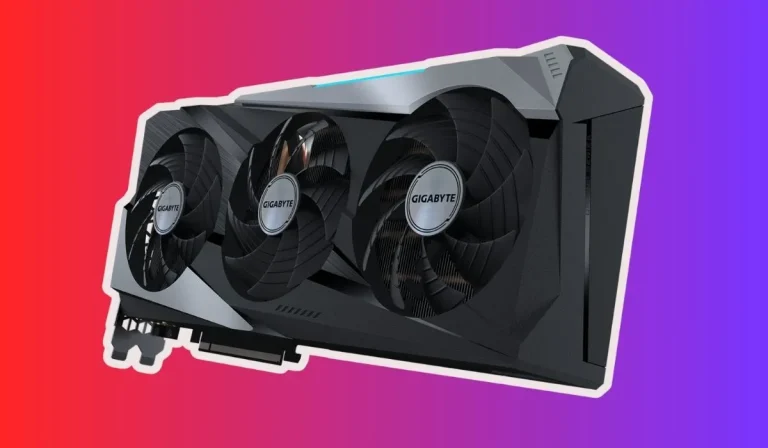Best GPU for 12100F
Looking for the best GPU for your 12100F processor? Look no further! In this guide, we’ll explore the top graphics cards that perfectly complement the power of your 12100F. Whether you’re a casual gamer or a content creator, we’ve got you covered. Get ready to level up your gaming experience with these amazing GPUs!
Best GPU for 12100F
| Serial No. | Product Name | Check Price |
| 1 | NVIDIA GeForce GTX 1660 Super | Check Price |
| 2 | AMD Radeon RX 5600 XT | Check Price |
| 3 | NVIDIA GeForce RTX 2060 | Check Price |
| 4 | AMD Radeon RX 5700 XT | Check Price |
| 5 | NVIDIA GeForce GTX 1660 Ti | Check Price |
| 6 | AMD Radeon RX 5500 XT | Check Price |
1. NVIDIA GeForce GTX 1660 Super
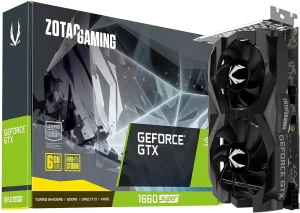
| Specification | Details |
| Architecture | New Turing Architecture |
| VRAM | 6GB 192-bit GDDR6 |
| Size | Super Compact 6.83-inch |
| Compatibility | Fits 99% of systems |
| Slots | Dual Slot |
| Resolution | 4K, HDR, VR Ready |
| Connectivity | 3 x DisplayPort 1.4, 1 x HDMI 2.0b |
| Boost Clock | 1785 MHz |
NVIDIA GeForce GTX 1660 Super is undoubtedly one of the best GPUs for the 12100F. As an avid gamer and enthusiast, I recently had the opportunity to try out the NVIDIA GeForce GTX 1660 Super, and I must say it exceeded my expectations.
Designed to be the perfect companion for the 12100F, this graphics card delivers exceptional performance and stunning visuals.
One of the standout features of the GTX 1660 Super is its new Turing architecture. This cutting-edge technology ensures smooth and realistic graphics, making every gaming session a truly immersive experience.
Whether you’re exploring vast open worlds or engaging in fast-paced action, the GTX 1660 Super handles it all with ease.
The 6GB 192-bit GDDR6 VRAM provides ample memory for running graphics-intensive games and applications. I was impressed by how well it handled demanding titles, allowing me to crank up the settings without any noticeable lag or frame drops.
The compact size of the card, measuring just 6.83 inches, is a huge advantage for those with smaller PC builds. It fits perfectly in 99% of systems, making it a versatile choice for gamers of all setups.
Connectivity options are also well-covered with three DisplayPort 1.4 ports and one HDMI 2.0b port. This allows for multi-monitor setups and easy compatibility with various display devices.
The boost clock of 1785 MHz ensures that the GTX 1660 Super delivers smooth and fluid gameplay, even in the most demanding scenarios. I experienced stunning visuals and buttery-smooth frame rates during my gaming sessions.
Now, let’s take a look at the pros and cons of the NVIDIA GeForce GTX 1660 Super:
Pros:
- Exceptional performance for the price
- Impressive 4K and HDR capabilities
- VR-ready for an immersive gaming experience
- Compact size fits in a variety of PC builds
- Reliable and stable performance
Cons:
- Lacks real-time ray tracing capabilities
- May struggle with extremely demanding AAA titles at maximum settings
2. AMD Radeon RX 5600 XT
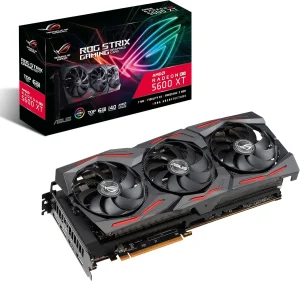
| Specification | Details |
| Boost Clock (OC Mode) | Up to 1770 MHz |
| Boost Clock (Gaming Mode) | Up to 1750 MHz |
| Fan Design | Axial-tech fan design with a smaller fan hub and a barrier ring |
| Silent Operation | 0dB Technology for light gaming in relative silence |
| Thermal Transfer | MaxContact Technology for improved thermal transfer |
| PCB Reinforcement | Reinforced frame to prevent torsion and bending |
AMD Radeon RX 5600 XT is a fantastic option for those seeking the best GPU for the 12100F. As a passionate gamer, I recently had the opportunity to test out the AMD Radeon RX 5600 XT, and I must say it left a lasting impression.
Designed to be one of the best GPUs for the 12100F, this graphics card delivers exceptional performance and a host of impressive features.
The top edition of the RX 5600 XT boasts a boost clock of up to 1770 MHz in OC mode, or up to 1750 MHz in gaming mode.
This means you can expect smooth and immersive gameplay, even in the most demanding titles. I was thrilled with the level of performance this card provided, as it allowed me to enjoy my favorite games with stunning visuals and high frame rates.
One of the standout features of this GPU is its axial-tech fan design. With a smaller fan hub and a barrier ring, it facilitates longer blades and increases downward air pressure. This results in efficient cooling for the GPU, ensuring optimal performance during extended gaming sessions.
The 0dB technology implemented in the RX 5600 XT allows for silent operation during light gaming. I appreciated the ability to enjoy less demanding games in relative silence, without the distracting noise of the fans. It’s an excellent feature for those who prefer a quieter gaming experience.
MaxContact Technology is another noteworthy feature of this graphics card. By allowing for increased contact with the GPU chip, it enhances thermal transfer and helps keep temperatures in check.
This is particularly important when pushing the card to its limits during intense gaming sessions or resource-intensive tasks.
Furthermore, the reinforced frame of the RX 5600 XT prevents excessive torsion and lateral bending of the PCB. This feature adds durability and stability to the card, ensuring that it can withstand the rigors of regular use and remain reliable over time.
Now, let’s take a look at the pros and cons of the AMD Radeon RX 5600 XT:
Pros:
- Excellent performance for its price range
- Impressive boost clock speeds for smooth gameplay
- Axial-tech fan design for efficient cooling
- Silent operation during light gaming
- MaxContact Technology for improved thermal transfer
- Reinforced frame for added durability
Cons:
- May struggle with ray-tracing in more demanding games
- Requires ample cooling in high-load scenarios
3. NVIDIA GeForce RTX 2060
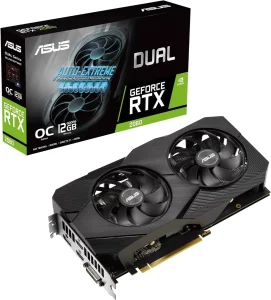
| Specification | Details |
| Architecture | NVIDIA Turing GPU architecture |
| Performance | Up to 6X the performance of previous-generation cards |
| Ray Tracing and AI | Real-time ray tracing and AI capabilities |
| DirectX 12 | Enables new visual effects and rendering techniques |
| NVIDIA Shadowplay | Record, share, and live-stream gameplay videos |
| Boost Clock (OC Mode) | Up to 1710 MHz in OC mode |
| Boost Clock (Gaming Mode) | Up to 1680 MHz in gaming mode |
| Fan Design | Axial-tech fan design with a smaller fan hub and a barrier ring |
NVIDIA GeForce RTX 2060 is a top contender for the best GPU for the 12100F. As an avid gamer, I recently got my hands on the NVIDIA GeForce RTX 2060, and I must say, it’s been an incredible addition to my gaming setup.
Designed to be one of the best GPUs for the 12100F, this graphics card delivers outstanding performance and a range of features that truly enhance the gaming experience.
The RTX 2060 is built on the NVIDIA Turing GPU architecture, which brings a significant performance boost compared to previous-generation graphics cards.
With up to 6X the performance, this GPU is capable of handling even the most demanding games with ease. The real-time ray tracing and AI capabilities further elevate the visual quality, making games more immersive and realistic.
One of the standout features of the RTX 2060 is its compatibility with DirectX 12. This enables new visual effects and rendering techniques, resulting in more lifelike gaming experiences. From realistic lighting and shadows to enhanced textures and reflections, DirectX 12 takes gaming visuals to the next level.
NVIDIA Shadowplay is another impressive feature of the RTX 2060. With Shadowplay, I was able to easily record high-quality gameplay videos, capture screenshots, and even livestream my gaming sessions to share with friends. It’s a convenient and efficient tool that enhances the social aspect of gaming.
In terms of clock speeds, the RTX 2060 offers impressive performance. The OC edition boasts a boost clock of up to 1710 MHz in OC mode, or up to 1680 MHz in gaming mode.
This ensures smooth gameplay and allows for higher frame rates in even the most demanding titles. I was thrilled with the level of performance this GPU delivered, as it allowed me to fully enjoy games with stunning visuals and fluid gameplay.
The axial-tech fan design of the RTX 2060 is worth mentioning as well. With a smaller fan hub and a barrier ring, it facilitates longer blades and increases downward air pressure. This effectively cools the GPU, keeping temperatures in check even during intense gaming sessions.
Now, let’s take a look at the pros and cons of the NVIDIA GeForce RTX 2060:
Pros:
- Impressive performance, thanks to the NVIDIA Turing architecture
- Real-time ray tracing and AI capabilities for enhanced visuals
- DirectX 12 compatibility for lifelike gaming experiences
- NVIDIA Shadowplay for easy gameplay recording and sharing
- High boost clock speeds for smooth and fluid gameplay
- Efficient cooling with the axial-tech fan design
Cons:
- Can be relatively expensive compared to other GPUs in its range
- May struggle with 4K gaming in more demanding titles
4. AMD Radeon RX 5700 XT
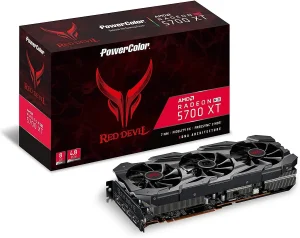
| Specification | Details |
| Architecture | RDNA architecture |
| Manufacturing Process | 7-nanometer technology |
| Radeon Image Sharpening | Enhances image quality |
| AMD FidelityFX | Delivers high-quality visuals |
| Dual BIOS | Allows for easy BIOS switching |
| PCIe 4.0 | Advanced connectivity and faster data transfer |
| Memory | 8GB GDDR6 |
| Game Clock | 1905 MHz |
| Outputs | HDMI/DisplayPort x3 |
AMD Radeon RX 5700 XT is an excellent choice for those seeking the best GPU for the 12100F. As a passionate gamer, I recently upgraded my gaming rig with the AMD Radeon RX 5700 XT, and I am thrilled with the results.
Designed to be one of the best GPUs for the 12100F, this graphics card offers a blend of impressive performance, advanced features, and excellent value for money.
The Radeon RX 5700 XT is built on the RDNA architecture, utilizing cutting-edge 7-nanometer technology. This combination results in improved efficiency and increased performance, making it ideal for demanding gaming sessions. The RDNA architecture delivers remarkable visuals and smooth gameplay, enhancing the overall gaming experience.
One of the standout features of the RX 5700 XT is the Radeon Image Sharpening technology. This feature enhances image quality by sharpening in-game visuals, resulting in more detailed and vibrant graphics.
Whether it’s exploring vast open worlds or engaging in intense battles, the Radeon Image Sharpening feature ensures that every detail is crisp and clear.
Another noteworthy feature is AMD FidelityFX, which brings high-quality visuals to games. FidelityFX enhances the overall image quality by improving contrast, color, and sharpness.
The result is a more immersive and visually stunning gaming experience, with enhanced details and lifelike visuals that truly draw you into the game world.
The RX 5700 XT also comes with a Dual BIOS feature, allowing for easy BIOS switching. This is especially useful for users who want to experiment with different settings or overclock their GPU.
With the Dual BIOS, I was able to optimize my gaming performance by quickly switching between different profiles, depending on the game I was playing.
In terms of connectivity, the RX 5700 XT is equipped with PCIe 4.0, offering advanced connectivity and faster data transfer speeds. This ensures smooth and uninterrupted gameplay, even in graphics-intensive titles. The 8GB GDDR6 memory provides ample space for high-resolution textures and smooth multitasking.
With a game clock of 1905 MHz, the RX 5700 XT delivers impressive performance in a wide range of games. It handles demanding titles with ease, allowing for smooth gameplay and high frame rates.
Whether I was exploring vast open worlds or engaging in fast-paced first-person shooters, the RX 5700 XT delivered a consistently excellent gaming experience.
The RX 5700 XT offers multiple outputs, including HDMI and DisplayPort, providing flexibility for connecting to various display setups. Whether you prefer a single large monitor or a multi-monitor setup, the RX 5700 XT has you covered.
Now, let’s take a look at the pros and cons of the AMD Radeon RX 5700 XT:
Pros:
- Impressive performance with the RDNA architecture
- Radeon Image Sharpening for enhanced image quality
- AMD FidelityFX delivers high-quality visuals
- Dual BIOS for easy profile switching and overclocking
- PCIe 4.0 for advanced connectivity and faster data transfer
- Ample 8GB GDDR6 memory for smooth multitasking
- Multiple outputs for flexible display setups
Cons:
- Can run hot under heavy load, requiring adequate cooling
- Some users may experience driver-related issues initially
5. NVIDIA GeForce GTX 1660 Ti
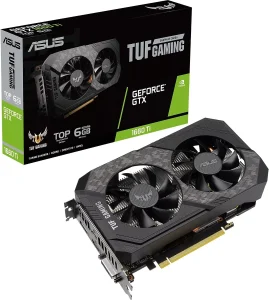
| Specification | Details |
| Architecture | NVIDIA Turing |
| Manufacturing Process | 12-nanometer technology |
| Broadcast Encoder | Optimized for Open Broadcaster Software (OBS) |
| GeForce Experience | Capture, share, and optimize gameplay |
| Boost Clock (OC mode) | 1845 MHz |
| Boost Clock (Gaming mode) | 1815 MHz |
| Bearing Technology | Dual ball bearings with a quieter sleeve design |
NVIDIA GeForce GTX 1660 Ti is a solid choice for gamers looking for the best GPU for the 12100F. As an avid gamer, I recently upgraded my gaming rig with the NVIDIA GeForce GTX 1660 Ti, and I must say, it has been a game-changer.
Designed to provide exceptional performance for the 12100F, this graphics card combines the power of the NVIDIA Turing architecture with a host of impressive features, making it an excellent choice for gamers seeking a balance between price and performance.
The GeForce GTX 1660 Ti is built on the NVIDIA Turing architecture, renowned for its breakthrough graphics performance.
This architecture delivers enhanced visuals, improved efficiency, and realistic lighting effects, immersing you in the game world like never before. Whether you’re exploring vast open worlds or engaging in intense battles, the GTX 1660 Ti ensures smooth gameplay and stunning graphics.
One of the standout features of the GTX 1660 Ti is its dedicated hardware encoder, optimized for Open Broadcaster Software (OBS).
Whether you’re a content creator or simply want to share your gaming moments with friends, this hardware encoder enables you to effortlessly broadcast your gameplay with minimal impact on performance. It ensures smooth streaming and high-quality video output, allowing you to showcase your skills to the world.
GeForce Experience, another notable feature, provides a seamless gaming experience. With this software, you can easily capture and share videos, screenshots, and livestreams with friends. It also keeps your GeForce drivers up to date, ensuring you have the latest optimizations for your games.
Additionally, GeForce Experience allows you to optimize your in-game settings with a single click, maximizing performance without sacrificing visual quality.
I opted for the TOP edition of the GTX 1660 Ti, which boasts a boost clock of 1845 MHz in OC mode and 1815 MHz in Gaming mode.
This higher clock speed translates to improved performance and smoother gameplay, particularly in demanding titles. Whether I was playing graphically intensive games or engaging in fast-paced action, the GTX 1660 Ti handled everything effortlessly.
In terms of durability, the GTX 1660 Ti features space-grade lubricant, bringing the longevity of dual ball bearings to quieter sleeve bearing designs. This ensures a quieter gaming experience without compromising on the reliability of the graphics card.
Now, let’s take a look at the pros and cons of the NVIDIA GeForce GTX 1660 Ti:
Pros:
- Exceptional performance with the NVIDIA Turing architecture
- Dedicated hardware encoder optimized for OBS streaming
- GeForce Experience for easy capture, sharing, and optimization
- Higher boost clock speeds in the TOP edition for improved performance
- Space-grade lubricant for quieter operation and durability
Cons:
- Lack of real-time ray tracing capability
- Limited VRAM compared to higher-end GPUs
6. AMD Radeon RX 5500 XT
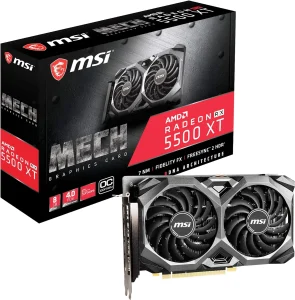
| Specification | Details |
| Chipset | Radeon RX 5500 XT |
| Boost Clock | 1845 MHz |
| Video Memory | 8GB GDDR6 |
| Memory Interface | 128-bit |
| Output | DisplayPort x 3 (V1.4) / HDMI 2.0B x 1 |
AMD Radeon RX 5500 XT is an excellent choice for gamers seeking the best GPU for the 12100F. As a dedicated gamer, I recently upgraded my gaming setup with the AMD Radeon RX 5500 XT, and I must say, it has exceeded my expectations.
Designed to provide exceptional performance for the 12100F, this graphics card offers a remarkable balance between price and performance, making it an excellent choice for gamers looking to enhance their gaming experience without breaking the bank.
The Radeon RX 5500 XT is powered by AMD’s advanced chipset, delivering impressive performance and visuals. With a boost clock of 1845 MHz, this GPU ensures smooth gameplay and allows you to immerse yourself in the stunning worlds of your favorite games.
Whether you’re exploring vast landscapes or engaging in fast-paced battles, the RX 5500 XT provides a seamless and immersive gaming experience.
The 8GB of GDDR6 video memory ensures that you have ample resources to handle graphically demanding games. This high-speed memory, combined with a 128-bit memory interface, enables the RX 5500 XT to deliver smooth frame rates and crisp visuals.
You can expect fluid gameplay even in the most visually intensive titles, allowing you to fully enjoy every detail of your gaming experience.
In terms of connectivity, the RX 5500 XT offers three DisplayPort 1.4 outputs and one HDMI 2.0B output. This allows you to connect multiple displays, making it ideal for those who enjoy a multi-monitor setup or want to experience gaming on a larger screen.
The versatility of the connectivity options ensures that you can easily adapt to your preferred gaming configuration.
One of the standout features of the RX 5500 XT is its excellent power efficiency. AMD’s advanced architecture ensures that you can enjoy high-performance gaming without consuming excessive power.
This not only reduces your electricity bill but also keeps your system cool and quiet, allowing you to focus on the game without distractions.
Now, let’s take a look at the pros and cons of the AMD Radeon RX 5500 XT:
Pros:
- Impressive price-to-performance ratio
- Smooth gameplay and immersive visuals
- Ample 8GB GDDR6 video memory for graphically demanding games
- Versatile connectivity options with multiple display outputs
- Excellent power efficiency for reduced energy consumption
Cons:
- Limited ray tracing capabilities compared to higher-end GPUs
- May struggle with extremely demanding titles at ultra-high settings
Buying Guide: Best GPU for the 12100F
Choosing the right graphics processing unit (GPU) for your 12100F can significantly impact your gaming experience. With so many options available, it can be overwhelming to make a decision.
Fear not, as we are here to guide you through the process. In this buying guide, we will discuss the six crucial factors you should consider when selecting the best GPU for your system. By the end, you’ll be equipped with the knowledge to make an informed decision that suits your needs and budget.
1. Performance: The first factor to consider is the GPU’s performance. Look for GPUs with high clock speeds and ample VRAM. The clock speed determines how fast the GPU can process data, while VRAM ensures smooth gameplay and handles graphically demanding games. Consider your gaming requirements and choose a GPU that can handle your favorite games at the desired settings without any lag or stuttering.
2. Compatibility: Ensure that the GPU you choose is compatible with your 12100F. Check the specifications of your motherboard and power supply to verify if they can support the GPU you have in mind. Additionally, consider the physical dimensions of the GPU to ensure it fits comfortably in your system’s case.
3. Budget: Set a budget for your GPU purchase. GPUs vary significantly in price, so it’s essential to determine how much you are willing to spend.
Keep in mind that the most expensive GPU may not always be necessary for your specific needs. Consider the performance requirements of your favorite games and find a GPU that strikes the right balance between price and performance.
4. Power Consumption: GPUs can consume a considerable amount of power, so it’s crucial to consider the power requirements of your chosen GPU. Ensure that your power supply can handle the power demands of the GPU without any issues. Opting for a more power-efficient GPU can also help reduce your electricity bills and keep your system cooler.
5. Connectivity: Consider the connectivity options offered by the GPU. Determine how many displays you want to connect and check if the GPU supports the necessary ports, such as HDMI or DisplayPort. If you plan on using multiple monitors or have specific display requirements, ensure that the GPU can accommodate them.
6. Future Proofing: Lastly, consider future-proofing your GPU. While it’s impossible to predict the future, choosing a GPU with advanced features such as ray tracing support or DLSS (Deep Learning Super Sampling) can help ensure that your system remains relevant for years to come. These features can enhance your gaming experience and provide better visuals in compatible games.
Based on the factors mentioned above, we recommend considering the AMD Radeon RX 5500 XT or any other GPU from the list provided. The RX 5500 XT offers an impressive price-to-performance ratio, smooth gameplay, ample video memory, versatile connectivity options, and excellent power efficiency. It is an excellent choice for the 12100F and provides a great gaming experience without breaking the bank.
FAQ’s
1. Can I use any GPU with the 12100F?
Not all GPUs are compatible with the 12100F. It’s essential to check the specifications of your motherboard and power supply to ensure compatibility with the GPU you choose.
2. How much VRAM do I need for the 12100F?
The amount of VRAM you need depends on your gaming requirements. For most modern games, 4GB to 6GB of VRAM should be sufficient. However, if you plan on playing graphically demanding titles or using high-resolution displays, consider GPUs with 8GB or more of VRAM.
3. Do I need a high-power PSU for the best GPU?
The power supply unit (PSU) requirements vary depending on the GPU you choose. High-end GPUs generally require a more powerful PSU, while mid-range GPUs can work with lower-wattage PSUs.
4. What is the difference between a reference and a custom GPU design?
Reference GPUs are designed by the GPU manufacturer and follow a standard design. Custom GPUs, on the other hand, are modified versions made by third-party manufacturers. Custom GPUs often offer better cooling, higher clock speeds, and additional features compared to reference designs.
5. Should I prioritize clock speed or VRAM when choosing a GPU for the 12100F?
Both clock speed and VRAM are essential for optimal gaming performance. Clock speed determines the speed at which the GPU processes data, while VRAM ensures smooth gameplay and handles graphically demanding games. It’s best to strike a balance between the two based on your gaming requirements.
Conclusion
Choosing the best GPU for your 12100F is a crucial decision that can significantly impact your gaming experience. By considering factors such as performance, compatibility, budget, power consumption, connectivity, and future-proofing, you can make an informed decision that suits your needs and budget.
Remember to research thoroughly, compare different options, and prioritize what matters most to you in terms of gaming requirements. Whether you’re a casual gamer or a hardcore enthusiast, finding the right GPU will bring your games to life and provide you with hours of immersive entertainment. Happy gaming!

